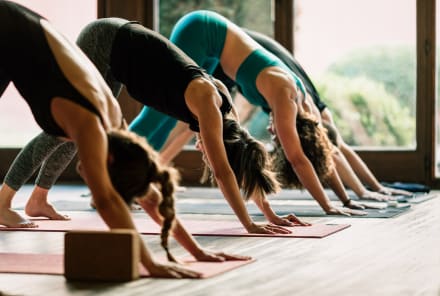Advertisement
5 Common Running Injuries + How To Treat & Prevent Them


Running involves repetitive motion with high impact, which can lead to a number of overuse injuries.
While running injuries are common, there are many ways to help prevent them (i.e., wearing the right shoe, running on gentle terrain, and resting when necessary). Understanding the most common running injuries is helpful for knowing how to treat and even prevent them.
When looking at a group of runners, about 30 to 40% will have at least one of the five most common running injuries, Robert Gillanders, P.T., DPT, tells mindbodygreen. "Lower half and lower extremity injuries are the most common, and the knee is far and away the most common of those."
Most common running injuries:
1. Runner's knee
Runner's knee (also called patellofemoral pain syndrome) affects approximately 30% of runners, Gillanders says. It may be caused by issues related to strength, flexibility, soft tissue mobility, and more.
What it is: Irritation of the joint between the thigh bone (a.k.a. the femur) and kneecap (a.k.a. patella).
How to treat it: Strengthening and stretching the muscles around the knee, including the quads, hamstrings, and hip muscles (specifically the glutes, and hip rotator muscles).
2. IT band syndrome
The iliotibial band (IT band) is the fibrous band supporting the outside of the knee, Gillanders explains. IT band syndrome is the second most common running injury he sees.
What it is: Excess stress on the IT band, commonly caused by instability of the leg or muscular imbalances.
How to treat it: Strengthening the muscles that control leg stability, including the glutes and the hips (especially lateral hips). Improving balance can be helpful, too. Gillanders recommends leg raises, foam rolling, lunges, and bridge exercises. Strength training, yoga, and Pilates may all be helpful to promote a balance of strength and flexibility.
Shin splints
Shin splints (also called medial tibial stress syndrome) commonly occur at the start of training. Gillanders sees these injuries primarily in high school running athletes or in runners who have had time off and are entering back into training.
What it is: Micro-tears in the muscles that surround the shinbone.
How to treat it: If shin splints are caused by overtraining, appropriate rest is imperative to prevent further injury. Improving flexibility in the calf, hips, ankles, and big toe will allow the leg to move properly while running and may help prevent injury in the future.
Achilles tendinitis
"The Achilles tendon is huge, and it can take a ton of stress, but it can be overwhelmed by that stress too," he says. This injury is common in sprint or hill runners. Symptoms often include swelling and pain around the tendon.
What it is: An overuse injury where the tendon becomes irritated.
How to treat it: Strength, flexibility, and balance are key components here. To help with pain, ice and rest the Achilles tendon. Stretching the heel and calf area can also help; try toe-to-wall stretches or calf raises.
Plantar fasciitis
Plantar fasciitis is generally caused by the repetitive nature and impact of running, and is the most common overuse foot injury1 in runners.
What it is: An inflammation or micro-tearing in the connective tissue on the bottom of the foot.
How to treat it: Resting this injury is difficult since everyday activity requires standing on the feet. These foot and toe stretches can help improve the pain, as can kneading the tissue with a golf, lacrosse, or tennis ball. Taping the foot, wearing compression socks, and wearing proper footwear can help disperse weight-bearing pressure.
Is it OK to run while injured?
Whether or not a runner can continue running while injured depends on the severity of the injury, Gillanders says.
He monitors his patients using a pain scale and advises them based on the following levels:
- 1 to 2 pain levels: Generally OK to train through.
- 3 to 6 pain levels: Consider shifting gears to cross-training.
- 7 and above: Rest and let the tissues heal.
Every individual is different, though, and should first consult a physical therapist or doctor before running while injured.
In the meantime, Gillanders suggests resting, icing, and elevating the injured area.
Tips for preventing running injuries:
Talk to experts about any running pain.
Gillanders says many of these common running injuries can be self-inflicted with improper training, increased intensity, a change in running shoes or terrain, etc.
Simply talking to a doctor or physical therapist about these factors can help them understand what may be causing the injuries and help treat them.
Recognizing these factors can also prevent injuries going forward.
While running coaches and personal trainers are not equipped to diagnose or treat running injuries, they can provide tips regarding running gait, training schedules, proper terrain, and other factors that may help keep injuries at bay.
Start slowly and progress.
Increasing speed and distance at a comfortable pace is an easy way to reduce the risk of injuries.
The general rule of thumb, according to Gillanders, is not to increase weekly mileage by more than 10%.
For the impatient or competitive runners, keep in mind that it's better to start slow and make progress than to become injured and have to stop running altogether.
Allow time to recover between runs.
One way to do this is through cross-training. "Whether it's swimming in the pool, being on the elliptical, or riding a bike," he says, "the body will benefit from cardiovascular exercise. It doesn't always have to be running."
Pilates and yoga are other good ways to continue strengthening the body while also reducing risks of overuse, physical therapist Meghan Cass, P.T., DPT, previously told mbg.
And a rest day—full stop—is also important every now and then. For those who use exercise as a way to support mental health, try meditating or journaling on those full rest days.
Watch Next
Enjoy some of our favorite clips from classes
Enjoy some of our favorite clips from classes
What Is Meditation?
Mindfulness/Spirituality | Light Watkins
Box Breathing
Mindfulness/Spirituality | Gwen Dittmar
What Breathwork Can Address
Mindfulness/Spirituality | Gwen Dittmar
The 8 Limbs of Yoga - What is Asana?
Yoga | Caley Alyssa
Two Standing Postures to Open Up Tight Hips
Yoga | Caley Alyssa
How Plants Can Optimize Athletic Performance
Nutrition | Rich Roll
What to Eat Before a Workout
Nutrition | Rich Roll
How Ayurveda Helps Us Navigate Modern Life
Nutrition | Sahara Rose
Messages About Love & Relationships
Love & Relationships | Esther Perel
Love Languages
Love & Relationships | Esther Perel

















